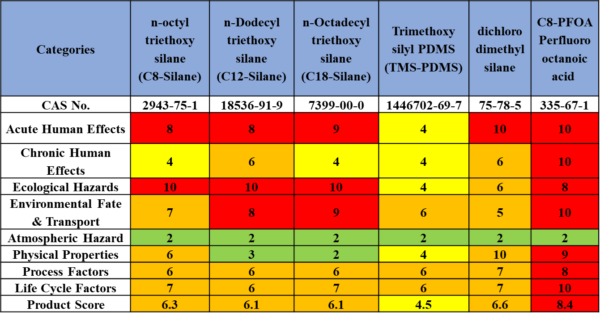PFAS-Free Repellent Coatings: A Safer Alternative for Textiles

The global push to replace PFAS-based fabric treatments has driven significant research into safer, more sustainable liquid-repellent coatings.
A recent study highlights two alternatives: long alkyl chain silanes and trimethoxy silyl-terminated polydimethylsiloxane (TMS-PDMS). These materials create liquid-like surfaces that effectively repel water and oils without the health and environmental risks associated with PFAS. Nevertheless, using a novel toxicity assessment method (P2OAsys), linear PDMS demonstrated a moderate toxicity score of 4.5, unlike silanes, with a high toxicity score of> 6 and PFAS>8.
You can also read: TFA: A Sustainable Alternative to PFAS?
Innovative Materials for Repellency
PDMS (Polydimethylsiloxane) emerged as a standout material due to its non-toxic, biocompatible, and cost-effective properties. With a low surface energy of approximately 20 mN/m and a flexible structure, PDMS coatings offer excellent water and oil repellency. Its low glass transition temperature (-127°C) also ensures durability and adaptability to fabric surfaces.
While also effective, long alkyl chain silanes exhibit slightly higher toxicity compared to PDMS. Their flexibility and low surface energy make them suitable for liquid repellency but may not match PDMS’s environmental safety profile.

Liquid repellent fabric coatings. Courtesy of A comparative study of alkyl chain silanes and poly dimethyl siloxane liquid-like brushes as PFAS-free liquid-repellent fabric coatings,
Superior Liquid Repellency Performance
Fabrics treated with F-3600 PDMS and F–C12 silane delivered exceptional results, with water contact angles exceeding 150°. These coatings also outperformed other formulations in oil repellency. However, using longer chains or higher molecular weights, such as F-C18 or F-12000, reduced the coatings’ liquid-like behavior, leading to diminished performance. This highlights the importance of optimizing molecular structure for maximum repellency.
Environmental and Mechanical Advantages
The study used the P2OAsys toxicity assessment tool to evaluate environmental impact. PDMS coatings scored significantly lower on toxicity (~4.5) compared to silanes (>6) and PFAS-based coatings (>8). This confirms PDMS as an environmentally friendly alternative to traditional treatments.
Regarding durability, PDMS-treated fabrics, especially with the F-3600 formulation, maintained their superhydrophobic and omniphobic properties after rigorous laundering and abrasion tests. Unlike silane-treated fabrics, which exhibited reduced flexibility due to Si-O-Si bonding networks, PDMS retained the fabric’s original mechanical strength.

Toxicity assessment with P2OAsys assessment scores. Courtesy of A comparative study of alkyl chain silanes and poly dimethyl siloxane liquid-like brushes as PFAS-free liquid-repellent fabric coatings.
Sustainable Applications for the Future
These PFAS-free coatings present exciting opportunities for industries seeking non-toxic and durable textile treatments. Potential applications include protective apparel, stain-resistant upholstery, and medical textiles. By offering both performance and safety, PDMS and silane coatings represent a significant step forward in creating sustainable solutions for liquid-repellent fabrics.
As the world phases out harmful substances like PFAS, innovations like these demonstrate how advanced materials can meet environmental and functional demands.
To read the complete study click here.
